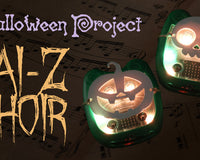Experiment 10 from the Inventors Kit for Arduino. In which we explore using an RGB LED. Included in this resource are code downloads, a description of the experiment, and also a video walkthrough. It provides additional help and is not meant to replace the documentation that ships with the kit.  Arduino is an open-source code-able electronics platform. The boards can process inputs from many sensors, and also control outputs such as LEDs and motors. The Arduino is controlled by the code with which it is programmed. This code is written in the Arduino programming language, using the Integrated Development Environment (IDE). Once complete, the code is easily transferred to the board using a simple USB lead.
Arduino is an open-source code-able electronics platform. The boards can process inputs from many sensors, and also control outputs such as LEDs and motors. The Arduino is controlled by the code with which it is programmed. This code is written in the Arduino programming language, using the Integrated Development Environment (IDE). Once complete, the code is easily transferred to the board using a simple USB lead.
Inventors Kit for Arduino - Exp 10 Using An RGB LED:
This experiment puts the RGB LED to use. An RGB LED is a special LED that contains three separate LEDs in one package. As you might have guessed the three LEDs are Red, Green and Blue. The light from these LEDs can then be mixed together to allow for the creation of many colours. We can use the PWM outputs of the Arduino to have a very fine control over the colours and also shades. The RGB LED included in this Inventor’s pack is a common cathode LED which means all three LEDs inside the package share the same negative leg. The aims of this experiment are:- To use an RGB LED.
- And also to observe how different colours are made from mixing red, green and blue light.
Video Walkthrough:
Exp 10 Code:
Either open a new Sketch then create the following code by typing in the editor window, or, copy and paste it straight into the editor
/*
Mix RGB colours usign buttons to control the values
Red and Green are controlled by buttons - which trigger an interrupt
Blue is controlled by reading the value of an analog input.
We dont use 3 interrupts as the minimum number available on all Arduinos is 2,
so this code should run on all, with possibly minor changes to where the interrupt is plugged in.
*/
//define some human readable shorcuts for the pins of each LED
#define RED_IN 2
#define GREEN_IN 3
#define BLUE_IN A0
#define RED_OUT 9
#define GREEN_OUT 10
#define BLUE_OUT 11
//Variables used in interrupts are declared volatile, as they may be changed since you last looked at them
volatile int RedValue = 0;
volatile int GreenValue = 0;
int BlueValue = 0;
void setup()
{
//Pins connected to buttons are inputs
pinMode(RED_IN,INPUT);
pinMode(GREEN_IN,INPUT);
//Setup Interrupts on the input buttons
attachInterrupt(digitalPinToInterrupt(RED_IN), OnRedButtonPressed, FALLING);
attachInterrupt(digitalPinToInterrupt(GREEN_IN), OnGreenButtonPressed, FALLING);
//Pins connected to the RGB LED are PWM Outputs.
pinMode(RED_OUT,OUTPUT);
pinMode(GREEN_OUT,OUTPUT);
pinMode(BLUE_OUT,OUTPUT);
}
/*
* The interrupt routines for Red and Green values.
* When the value gets to 250 it will return to Zero,
* So the light will get brighter and then go out
*/
void OnRedButtonPressed()
{
if(RedValue<250)
{
RedValue+=5;
}
else
{
RedValue = 0;
}
}
void OnGreenButtonPressed()
{
if(GreenValue<250)
{
GreenValue+=5;
}
else
{
GreenValue = 0;
}
}
/*
The main loop reads the analogue value and converts the input analog range (0-1023)
to the output value (0-255)
It then puts out the PWN values for all colours
*/
void loop()
{
int PotValue = analogRead(BLUE_IN);
BlueValue = map(PotValue,0,1023,0,255);
analogWrite(RED_OUT,RedValue);
analogWrite(GREEN_OUT,GreenValue);
analogWrite(BLUE_OUT,BlueValue);
}Inventors Kit Extra Resources:
Each of the ten experiments has been designed to ease you into coding and also physical computing for the Arduino. The experiments have been chosen to cover the key concepts of physical computing and they also increase in difficulty as you progress. If you are new to this, even the least complex examples can be quite challenging. With this in mind, we created walkthrough videos for each of the experiments. Our presenter talks you through the circuit in a way that backs up the information given in the booklet but in a style that some might find easier to absorb. As well as having a video walkthrough, each page also contains the code. Although it is always good to tackle the code yourself, it can be handy for testing your circuit. The code has been heavily commented as an extra learning resource. To get the most out of the experiment, once you've tested your circuit have a go at coding the experiment from scratch. Follow the links in the table below:| Exp No#. | Experiment Name. |
|---|---|
| Digital Inputs & Outputs. | |
| Light Sensor & Analog Inputs. | |
| Dimming an LED using a potentiometer. | |
| Using a transistor to drive a motor. | |
| Control a servo with a potentiometer. | |
| Setting the tone with a piezo buzzer. | |
| Using a seven segment display. | |
| Exploring wind power. | |
| Capacitor charge circuit. | |
| Using an RGB LED. |
©Kitronik Ltd – You may print this page & link to it, but must not copy the page or part thereof without Kitronik's prior written consent.






